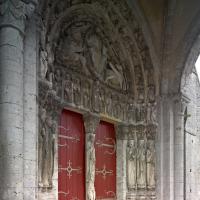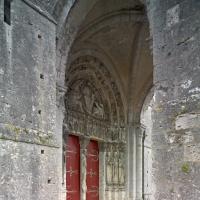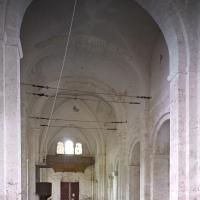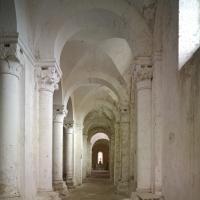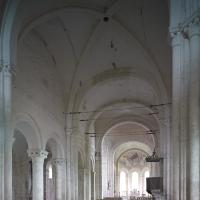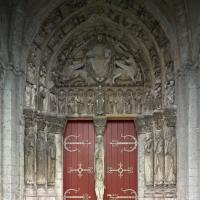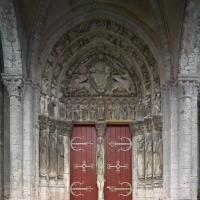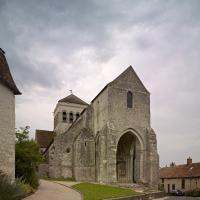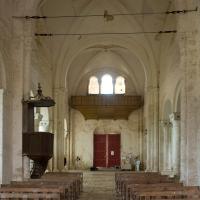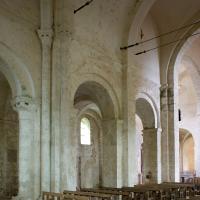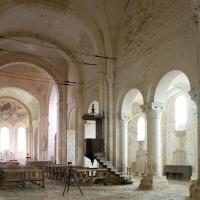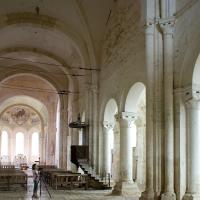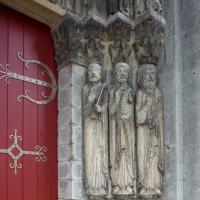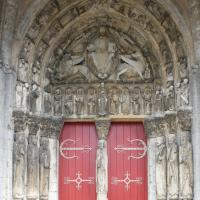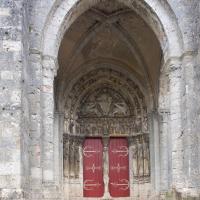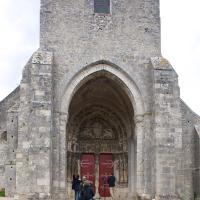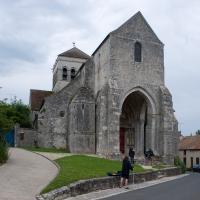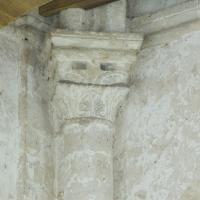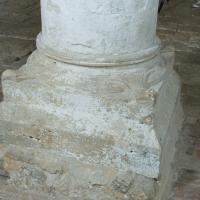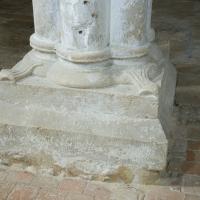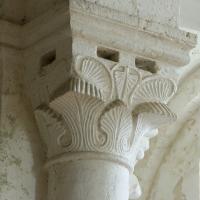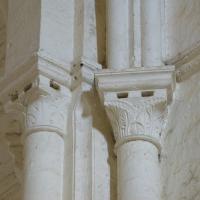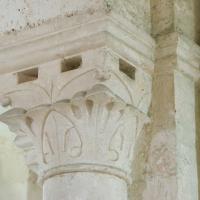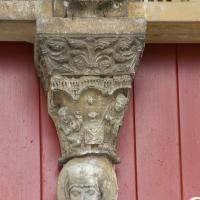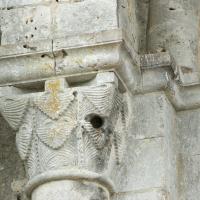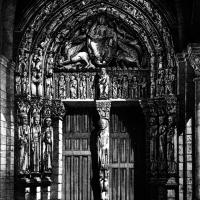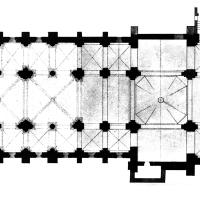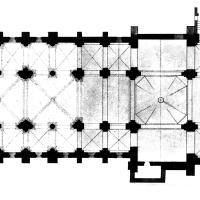Images
Notes
Date
Begun ca. 1100
Plan
A basilica terminated in the east by three apsidal chapels. Barrel vaulting in the chevet and first nave bay gives way to the rib vaulting in the western nave where the two great square bays are supported on alternating supports (compound and cylindrical columns). There is a great central tower at the crossing. In the west there is a central porch with an upper chapel recalling Carolingian precedents.
Elevation
Saint-Loup-de-Naud has one story elevation with no clerestory
Chronology
Construction began in the east during the early 12th-century; work progressed west with the western frontispiece dating to the 1160s.
Sculptural Program
Under a small vaulted porch, the west portal of Saint-Loup-de-Naud emerges with a program that tells both local and universal stories. While much of this portal has stylistic parallels elsewhere and subscribes to a particular theology, a large swath of the sculptural program relates to Saint Loup, the patron saint to whom this priory church was dedicated.
The tympanum consists of a central figure of Christ in Majesty surrounded by a Tetramorph. A scalloped border of clouds unites this group. Of the four symbols of the Evangelists, three are depicted holding books, with the exception of the eagle (the symbol of Saint John), which clutches a scroll in its talons. Based on a number of perceived iconographic disruptions, Clark Maines has suggested that the tympanum was reduced in size and relocated from another site. Similar evidence pertaining to the structure of the entire portal program suggests that a number of pieces in the ensemble were spolia from earlier buildings elsewhere.
Enthroned in the center of the lintel, the Virgin is significantly taller than the flanking seated apostles. The apostles are framed within an arcade, the spandrels of which are articulated with micro-architecture. These figures are depicted with books or scrolls, and for the most part they are oriented frontally, although those on the edges turn their heads, some facing the center of the lintel, and others angled in view of the archivolt. Maines believes these apostles were originally part of a "complete" twelve-apostle grouping, and that the lintel was partitioned and truncated for its placement here.
The trumeau figure depicts Saint Loup of Sens, the priory's patron saint, who is positioned frontally, enmeshed architectonically with the doorpost, his lower body in especially low relief.
The jambs rise without bases to foliate capitals. The impost is also foliated. Five male and one female column figures articulate the embrasures. The identities of the innermost pair of figures can be securely assigned as Saint Paul, on the left, and Saint Peter, on the right, but the degradation of the attributes of the remaining figures prevents their identification.
In the innermost archivolt, richly draped angels are shown holding censers and candlesticks. The outer archivolts are largely covered with scenes from the legend of Saint Loup; however, more universal iconography does occupy some of the voussoirs. To the left of the doorway, the Annunciation and Visitation are depicted in the lowest voussoirs of the outermost and central archivolts, respectively; to the right of the doorway, spanning the central and outer archivolts, the Magi appear before Herod, in the lowest row of voussoirs. The Saint Loup cycle consists of several scenes from the saint's legend, as well as a number of as-yet unidentified scenes. These are, from left to right, across the two outer archivolts: Saint Loup outwitting a devil; Saint Loup healing a blind man; Saint Loup baptizing the pagan duke Bosonis; Saint Loup opening the doors of Saint-Aignan d'Orléans by prayer; a miraculous Mass of Saint Loup (?); Saint Loup on an equestrian journey; hears heavenly choir; a woman with a book (unidentified); a hanging scene (?); a shepherd and ram which Saint Loup protects; Saint Loup (?); a man in contemplation before an altar; a woman in a church; a woman in prayer; a miracle of Saint Loup; and a musician. The keystone of the lowest archivolt features the Agnus Dei. A Manus Dei appears, its cruciform nimbus slightly askew, on the keystone of the central archivolt. Angels perched on a cloud adorn the keystone of the outermost archivolt.
Generally associated with the period exemplified by the Royal Portal at Chartres b-1107, this portal dates to around 1160, although the issues of spolia and reassembly make its precise dating difficult.
Significance
It is important for its sculptural program of early column figures and its tympanum with its Maiestas Domini dating to 1160-1170s, which is comparable to that at Chartres.
Location
Bibliography
Aufauvre, Amédée and Charles Fichot. Les Monuments de Seine-et-Marne: Description historique et archéologique et reproduction des édifices religieux, militaires et civils du département. Paris, 1858.
Bond, Sheila, and Clark Maines. "Architectural Monuments in Saint-Loup-de-Naud (Seine-et-Marne)." Bulletin monumental 153, no. 2 (1995): 184-90.
Bourquelot, Félix. "Notice historique et archéologique sur le prieuré de Saint-Loup-de-Naud (Seine-et-Marne)." In Bibliothèque de l'École des Chartes, 244-71, 1841.
Maines, Clark. The Western Portal of Saint-Loup-De-Naud, Outstanding Dissertations in the Fine Arts. New York: Garland Pub., 1979.
Roblot-de-Londre. "Notes sur L'église de Saint-Loup-De-Naud (Seine-et-Marne)." Revue Archéologique 30 (1929).


